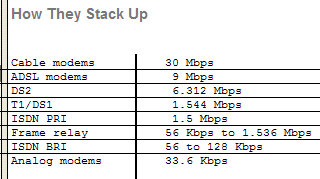| Imagine that you could buy a desktop computer with a
15,000-MHz processor, 1600 MB of RAM, and a 100-GB hard
drive for less than $20. Sure, you could run Word a little
faster and recalculate wall-size spreadsheets in the blink
of an eye. However, the real impact of that much power at
such a breakthrough price would be almost impossible to
predict, because it's the kind of breathtaking leap that
spawns new applications that weren't thinkable before. On-line bandwidth is on the verge of making just such a leap. The mythical system described above is about 100 times faster than today's PCs at one-hundredth the cost, and that's approximately the price/performance advantage that a new generation of broadband modems will deliver over existing phone lines and cable TV networks. Compared to the latest analog modems, it's a quantum leap in affordable bandwidth that spans two orders of magnitude for about one-hundredth the cost of a T1 dedicated phone line. Never before in the history of computing has there been such a jump. Microprocessors grow about twice as powerful only every 18 months, and analog modems are only about 10 times faster than they were 20 years ago. This comes not a minute too soon. The Internet boom has exposed the soft, white underbelly of the Net: agonizingly slow access through traditional analog modems. The supposed savior of the Internet is an unlikely hero: a squat, little box called a cable modem. Put this between a computer and the cable TV network, and suddenly you have access to Ethernet-like transport speeds. But it's not time to party with the cable guy yet. Sure, some power users will get a packet rush from these devices, but many obstacles stand in the way of this revolution, not the least of which are the performance bottlenecks that lurk deeper into the Internet along the backbone and among myriad servers. Even if the cable modem industry overcomes its lack of standards and proves better than alternatives like the telephone companies' broadband contender, Asymmetric Digital Subscriber Line (ADSL), bottlenecks may just be pushed further upstream. This revolution is going to take at least five years to complete. Nonetheless, the immediate result of the new generation of modems will be Internet access at broadband speeds of 1 to 5 Mbps for less than $40 a month. The long-term impact is an open question. At a minimum, broadband modems will shatter the boundaries between local and remote network resources, bringing the Internet and the World Wide Web as near to your PC as a LAN server. Webmasters will be able to build spectacular multimedia Web sites. Businesses and schools will inexpensively link their remote LANs into high-speed WANs without leasing expensive dedicated phone lines (see the figure "Building a WAN with Cable Modems"). Videoconferencing could finally become real. Broadband modems might even change common notions about computers. Users who are conditioned to measuring computer power in terms of megahertz and megabytes are just beginning to grasp the importance of on-line bandwidth. In the next decade, bandwidth could exert more influence over the evolution of computing than the ascent of CPU cycles and memory capacity. Is a computer fundamentally a computational machine or a communications device? Is it only a PC, or is it also a network computer? Is it a luxury item or a modern necessity? In the short term, however, broadband modems may instead cause you some problems. For the first time, the bandwidth bottleneck won't be the modem on your desktop; it will move somewhere further up the pipe. Some experts warn that if the rest of the infrastructure doesn't keep up, the Internet could eventually bog down under the traffic or collapse altogether. Perhaps the only thing that's certain is that a windfall of cheap bandwidth will seal the fate of unwired PCs. Already, users who can't reach a LAN or the Internet are the exception in businesses and schools. They're cut off from the convenience of e-mail, isolated from the community of newsgroups, and excluded from what are fast becoming the world's largest and most accessible libraries of human knowledge. Soon, a computer that has no access to network resources will seem like a disembodied brain in a jar. Copper vs. Coaxial Broadband modems aren't important just because they're fast; they're also noteworthy because they work on existing communications networks. There are two general types of broadband modems, one for each type of network. It's not yet clear which network will dominate broadband communications or if both networks will share the pie. On one side are the telephone companies (telcos, or RBOCs, for Regional Bell Operating Companies). They rule over a massive network of 600 million phone lines that's been under construction since Alexander Graham Bell invented the telephone in the 1870s. They're betting on ADSL. ADSL modems can pump data at rates as fast as 9 Mbps over the existing twisted-pair copper phone wiring. Opposing the telcos are the cable TV companies (cablecos, or MSOs, for multiple system operators). They command a smaller but still impressive network that dates from the 1960s and covers 90 percent of U.S. homes. They're betting on cable modems, which attach a computer to the coaxial-cable TV network at similar megabit speeds. Broadband technology is a genuine breakthrough because today's narrowband modems are hitting a brick wall. The latest analog modems work at 33.6 Kbps, a modest 16 percent improvement over 28.8 Kbps. You'll get that top speed only with a pristine connection, and it's just about the limit of what's possible on a voice-grade analog phone line, which is also known as the plain old telephone system (POTS). POTS has only 3.3 kHz of bandwidth. A 33.6-Kbps modem transmits nearly 11 bits of data per hertz. This is a remarkable technical achievement that approaches the theoretical limit. (Broadband modems typically manage fewer than 2 bits per hertz.) ISDN seems like the next logical step, but let's put it into perspective. Basic Rate ISDN carries 56 or 64 Kbps per B-channel, which is only about twice as fast as the latest analog modems. You can get as much as 128 Kbps with an ISDN modem that combines the two B-channels, but these middleband speeds aren't enough to propel on-line communications from the ASCII age into the future. Tomorrow's Web will be a lively and bandwidth-hungry world of streaming video, real-time audio, wide-area videoconferencing, Java applets, and 3-D Virtual Reality Modeling Language (VRML) environments. Won't ISDN get faster, repeating the steady progress of analog modems? It's not likely. ISDN's inefficient baseband modulation wastes bandwidth, and significantly changing ISDN would be like reinventing ADSL. Thus, ISDN is merely a small step toward the ultimate destination. Beyond Basic Rate ISDN are a number of higher-speed data-grade lines the telcos offer: Primary Rate ISDN (which bundles up to 24 Basic Rate B-channels to yield 1.5 Mbps), frame relay (56 Kbps to 1.536 Mbps), T1/DS1 (1.544 Mbps), DS2 (6.312 Mbps), Switched Multimegabit Data Service (SMDS)/DS3 (56 Kbps to 34 Mbps), STS-1 (51.840 Mbps), and others. There are also ADSL-like technologies, such as high-bit-rate digital subscriber line (HDSL), which usually require multiple twisted pairs to deliver megabit speeds. Even more-enlightened telcos charge heavily for this bandwidth. Pacific Bell — an aggressive marketer of digital subscriber lines in Silicon Valley — charges $525 to more than $6400 a month, depending on the service, plus installation fees ranging from $2000 to $6500. Some telcos charge more. Clearly, these are not affordable solutions for most businesses, schools, and home users. What about wireless? Some alternatives look interesting. DirecPC, from Hughes Network Systems, is a close cousin of DirecTV. The PC version transmits data from a geosynchronous communications satellite directly to a 24-inch dish antenna connected to your PC. The result is a highly asymmetrical network: 400 Kbps downstream. A standard analog modem carries upstream messages, so the maximum speed is 33.6 Kbps. The speeds are well short of what cable modems and ADSL offer. Another broadband wireless option will be local multipoint distribution service (LMDS). This is a two-way digital broadcasting system that uses ground-based transceivers, not satellites. Unlike DirecPC, LMDS isn't available yet; it requires a huge chunk of RF spectrum that the U.S. government is expected to auction this fall. It's not clear yet who will buy this spectrum or how much they will pay, but it will be expensive. End users will need a special LMDS modem that attaches to an Ethernet port, which limits maximum bandwidth to 10 Mbps. Both wireless alternatives require completely new infrastructures. Also, new wireless services must compete for a dwindling share of unallocated and extremely valuable broadcast spectrum. Meanwhile, there's virtually no limit to the amount of cable that the telecommunications industry can install if demand warrants. Of course, cable modems and ADSL have their drawbacks, too. Some vendors brag about data rates "1000 times faster" than analog modems. As we'll see in a moment, actual performance varies quite a bit, for a wide variety of reasons. The bandwidth isn't equally apportioned, so there's more data flowing downstream (from the network to the user) than upstream (from the user to the network). Also, the telecommunications industry tends to gloss over the infrastructure upgrades it will inevitably face when deploying these technologies on a mass scale. The fact is, neither ADSL nor cable modems are quite ready for prime time. Standards are shaky or incomplete, so modems from different vendors often can't talk to each other. Compared to analog modems, prices are relatively high (about $500). Only about 10 percent to 15 percent of the U.S. cable network can handle two-way traffic at megabit speeds. Business models are in flux because nobody knows just how much demand to expect. Nevertheless, neither technology is vapor. Both types of modems are available. Numerous trials prove beyond a doubt that they work. In some cases, the trials are tantamount to actual deployments. In 1997, standards will coalesce; manufacturers will drive down their costs and begin turning the modems into commodity products. By late in the century, spreading infrastructure improvements will make broadband modems available to millions of users. "We're looking at a five-year time frame," says analyst Larry Yokell, president of Convergence Industry Associates (Boulder, CO). Too long to wait? Remember, we're talking about a historic leap in the distribution of bandwidth. Even by the most optimistic projections, the concurrent progress of microprocessors, memory chips, and mass-storage devices won't come close. You might even hook up a broadband modem to the same computer you're using now. How They Work At first glance, broadband modems superficially resemble analog modems. They interface your computer to an external network and communicate with a compatible modem at the other end of the line by converting digital data into modulated RF signals. Likewise, they receive modulated RF signals and convert them back into digital data. These basic functions are common to all modems (see the figure "Inside a Broadband Modem"). What makes broadband modems so much faster is that they exploit a much wider swath of spectral bandwidth. Analog modems are limited to only 3.3-kHz POTS. By comparison, cable modems use the bandwidth of an analog TV channel, which is 6 MHz wide for NTSC and 8 MHz for PAL. Wider frequency exploitation translates into theoretical speeds of 8.448 Mbps and 30 Mbps for ADSL and cable modems, respectively. These sky-high speeds would quickly overwhelm a computer's serial port. Consequently, most broadband modems require a 10Base-T Ethernet port. This also makes it easier to hook up a broadband modem, because it doesn't need special protocols or drivers — any standard Ethernet stack will do. From the computer's point of view, it's on an Ethernet LAN, not a special network. The network interface card (NIC) sends Ethernet packets to the modem. The modem modulates the data and transmits it over the phone line or coaxial cable to the receiving modem at the other end of the connection. In the opposite direction, your modem converts the RF signals it receives back into Ethernet packets before sending them to the Ethernet card in your computer. Some broadband modems send modulated Ethernet packets over the phone or cable network. Others convert the Ethernet packets into asynchronous transfer mode (ATM) cells or proprietary-format packets before modulating the signal. This lack of standardization is one reason why modems from different vendors usually aren't interoperable today. (For cable modems, the modulation schemes aren't standardized, either.) You need the same vendor's modem at each end of the line to communicate. It's as if you would need a different analog modem every time you change Internet service providers (ISPs) or move to an area that's served by a different telco. This sorry situation probably won't last long. Several industry groups are working on interoperability standards to allow vendors to mass-produce broadband modems as low-cost commodity products. Eventually, both types of broadband modems will probably standardize on ATM as the network transport protocol and will dispense with 10Base-T connections in favor of internal cards that plug into expansion slots. Eventually, some PCs (and especially network computers) will integrate a broadband modem as a condensed chip set on their motherboards. "I think we can get pretty close to one-chip digital signal processing with this thing," says Jack Guedg, director of National Semiconductor's multimedia systems strategic marketing segment. "That will drive down the price of cable modems tremendously. But that won't happen until we've got large volumes and industry standards." In the meantime, almost all cablecos and some telcos are supplying modems to subscribers as part of their broadband service. Therefore, you won't get stuck with an obsolete modem. A monthly subscription fee of $30 to $40 will probably include the lease of a modem and unlimited Internet access. That's only $10 to $20 more than what most users are paying today for flat-rate access to the Internet at narrowband speeds. In most areas, middleband ISDN is a much more expensive option. Your Mileage May Vary What you don't get with ADSL — and particularly with cable modems — is an easily quantified amount of throughput. Realistically, you can expect 1 to 5 Mbps downstream and something less upstream. However, your actual throughput will vary according to a dizzying number of factors. These include the following: oddities in the cable and phone networks, asymmetric frequency allocations, unpredictable line noise, the speed of your computer and its Ethernet interface, and, with cable modems, the number of other people in your neighborhood who are on-line at the same time (see the figure "The Bandits of Bandwidth"). This isn't the case with ISDN, dedicated phone lines, and — to a lesser extent — analog modems. Broadband modems sacrifice some of their potential speed to bring megabit service to more customers over existing infrastructures. It would be ridiculously easy to make superspeed modems if everyone had fiber-optic cable running into their premises. Eventually, that will happen. However, the need for broadband is more immediate. It doesn't make sense to postpone progress for an infrastructure upgrade that will take decades. Phone Problems The telcos originally designed their network to carry analog voice conversations from one phone to another. It's a pervasive network with versatile point-to-point circuit switching, but it's handicapped by antiquated wiring that plays havoc with digital data. Take loading coils, for instance. Originally installed on long circuit loops to cancel noise during voice calls, they're essentially low-pass filters that cut off all frequencies above 4 kHz. Unfortunately, all digital modems require frequencies higher than 4 kHz. If there's a loading coil anywhere in the loop between the local distribution node and your premises, the phone company must remove it before you can get ISDN, ADSL, or any other digital service. Loading coils are the widely despised roach motels of digital networks: Bits check in, but they don't check out. Loading coils aren't the only problem by far. Among other things, phone networks are plagued by overlong loops (which attenuate signals), bridged taps (unterminated pairs), and cross-coupled interference (cross talk between wires in the feeder cables that run to neighborhood distribution nodes). Some of the wiring is so ancient that nobody has any idea how much of it might be compatible with digital service. Tac Berry, vice president of marketing for Amati Communications, an ADSL modem vendor, estimates that ADSL service can reach 75 percent to 95 percent of U.S. phone customers without major upgrades. Kim Maxwell, a telecommunications industry analyst and chairman of the ADSL Forum, estimates that 15 percent to 20 percent of the phone network is blighted with loading coils, let alone other problems. Even under ideal conditions, ADSL throughput depends on the length of the local loop. The maximum electrical resistance an ADSL signal can overcome is about 1500 ohms, which translates into 15,000 feet of 26-gauge twisted-pair copper wire or 18,000 feet of 24-gauge wire, which is larger. At that distance, ADSL can deliver about 1.544 Mbps downstream and 16 Kbps upstream. (Note the approximate 10-to-1 downstream/upstream ratio.) The ADSL Forum estimates that 80 percent of the phone customers in the U.S. are on local loops of 18,000 feet or less. In some countries, loops are shorter and nearly everyone is within 18,000 feet. That's good enough for downstream ADSL that matches T1 service. As the loop gets shorter, attenuation decreases and throughput rapidly increases. At 16,000 feet, ADSL can deliver 2.048 Mbps downstream. At 12,000 feet, it's 6.312 Mbps. And at 9000 feet — the average line length for most U.S. customers, according to Maxwell — ADSL can deliver its nominal maximum speed of 8.448 Mbps downstream and 640 Kbps upstream. Again, these rates assume a clean connection, which is rarely the case. ADSL modems use frequency-division multiplexing (FDM) or echo cancellation to make the most of that noisy pipe. After splitting off a 4-kHz band for POTS, they divide the higher-frequency region into upstream and downstream data paths. One ADSL standard, which is known as discrete multitone (DMT), allocates 255 subchannels about 4 kHz wide and then modulates a separate signal on each subchannel. Each signal encodes the data using quadrature amplitude modulation (QAM). This prevents noise in one subchannel from completely disrupting the connection. It also lets the modems dynamically adjust their data rates to compensate for line noise. Cross-coupled interference is largely to blame for the asymmetry of ADSL. A phone line is not a continuous, unbroken pair of wires that runs from a central office to your home or workplace. The huge cables from a central office might bundle hundreds or even thousands of pairs together. As these cables spread out through neighborhoods, they funnel down to 50-pair cables and finally to the single pair that reaches your phone jack. Bellcore estimates that a typical U.S. phone line crosses 22 splices during that journey. If ADSL modems tried to send high-speed signals in both directions, the line noise and cross talk within the 50-pair cables would significantly reduce their effective data rates. Asymmetric data paths are therefore a compromise that leverages bandwidth and extends ADSL service to more potential customers. The result is that the existing phone network drains enough performance from ADSL modems to produce a wide gap between the theoretical and real-world speeds. Cable Problems Cable modems are dogged by legacy problems, too. The cablecos originally designed their networks to carry analog TV programming from a central head-end to homes. Coaxial cable has more inherent bandwidth than twisted-pair copper, but cable TV networks are handicapped by an unswitched tree-and-branch topology that was never intended for two-way or point-to-point communications. They also suffer from unterminated connectors, cheap splitters, amateur-installed wiring, a scarcity of the two-way amplifiers required for bidirectional transmission, and high susceptibility to RF interference. The lack of sophisticated switching puts cable networks at a disadvantage for some modem applications. "Cable modems assume the whole world is IP, that everything you need is on the Internet," says Tom Ransom, director of corporate communications at Cardinal Technologies (Lancaster, PA), which makes ISDN modems. Cable modems may bring lightning-speed Internet access to consumers, but business customers may feel shortchanged. "There's no point-to-point communication, and we find that many people still need access to computers at remote locations," Ransom says. Estimates of how many cable networks in the U.S. are capable of two-way broadband data service range all over the ballpark. At the low end, some analysts say only 5 percent of the cable infrastructure can deliver broadband service without upgrades. At the high end, Goldman Sachs estimates that 40 percent of Time Warner's networks are two-way-capable. Bruce Ravenel, president and CEO of TCI Internet Services, says 15 percent of U.S. cable networks are ready for broadband modems, and he predicts that this will grow to 30 percent or 35 percent by the end of 1997. One thing is certain: The cablecos are investing billions in upgrades. They have to, if they want to survive in the new competitive climate fostered by the U.S.Telecommunications Act of 1996. Deregulation lets the telcos deliver local data services and even TV programming. It also lets the cablecos deliver local voice telephony, which — like broadband data — requires two-way capability and better switching. Time Warner Cable is spending at least $4 billion to upgrade its networks to hybrid fiber-coaxial (HFC) standards, and other cablecos are also investing large sums of money. As a stopgap solution, some cablecos whose networks aren't ready for two-way communications will require cable modem users to send data upstream over regular phone lines with 28.8-Kbps analog modems. Zenith and U.S. Robotics have such a system, with Zenith supplying the cable modems and U.S. Robotics supplying the head-end equipment. It's not a pretty solution, but it still gives users megabit speeds downstream. Downstream bandwidth isn't a problem for cable networks because they've always needed it for analog TV. Total bandwidth varies according to the cableco's head-end equipment, but most HFC networks can transmit signals from 54 to 750 MHz. That's enough for 116 NTSC channels. Many of those channels aren't used, freeing them for such services as digital TV, voice telephony, and cable modems (see the figure "HFC Frequency Allocations"). By reserving a single 6-MHz channel for broadband data, a cable network can provide a 30-Mbps downstream path to all the users on a neighborhood node. In an HFC network, this node bridges the fiber-optic backbone to the coaxial-cable feeder line, which in turn feeds the drop cables that lead to individual premises. A single feeder line might serve 500 to 2000 sites (see the figure "A Hybrid Fiber-Coaxial Network"). On the basis of this statistic, some cable modem promoters recklessly claim to deliver 30 Mbps of downstream bandwidth. But that's aggregate bandwidth on the feeder line, shared by everyone in the neighborhood who's using a cable modem at the same time. As on a LAN, actual throughput depends on who's doing what. If all your neighbors have cable modems and are downloading the latest version of Netscape Navigator, you'll be lucky to get a trickle of leftover bandwidth. Naturally, the telcos make a big deal out of this. ADSL modems use phone lines, so they don't have to share bandwidth among other users. The cablecos have a snappy answer: If they come, we will build it. To start with, it's not clear how much demand there will be for cable modems — 30 Mbps might be plenty for a typical neighborhood. If it isn't, one option is to subdivide the fiber nodes, creating neighborhood subnetworks with as few as 125 customers on a 30-Mbps feeder line. Another option is to allocate additional 6-MHz channels to data services. Modern HFC networks can do this at the node level, assigning the same channel to multiple nodes throughout a network. Finally, the most up-to-date cablecos can light up their dark fiber. Time Warner's HFC networks run six fiber cables to the fiber nodes; currently, they're using only two. Lighting up all the fiber would instantly triple the bandwidth, even without the other changes. "We'll die of old age before we run out of bandwidth," says Mario Vecchi, CTO of Excalibur Group (Stamford, CT), a Time Warner subsidiary. Asymmetric Again Unfortunately, the upstream paths in cable networks aren't as well endowed as the downstream paths. Because the original network architects didn't anticipate a need for equal bandwidth in both directions, the upstream path from the user to the head-end is limited to a frequency range of 5 to 42 MHz. This region falls just below the lowest cable TV channels, and its primary purpose was simple pay-per-view signaling. Now it has to serve as the return path for interactive TV, voice telephony, and cable modems. Worse than that, it's the junkyard of the RF spectrum. Those frequencies are extremely vulnerable to ingress noise from unterminated connectors, bad wiring, household appliances, shortwave radio, and even Air Force radar. Because of the tree-and-branch topology, that noise multiplies all the way down the line. In fact, one reason why there's no industry standard for cable modems is that engineers can't agree on the best way to fight the noise. Downstream, most cable modems use 64- or 256-QAM modulation, because it's fast and spectrally efficient. Upstream, there's too much ingress noise for either scheme. Thus, cable modems resort to slower but more robust modulation such as quadrature phase shift-keying (QPSK) or discrete wavelet multitone (DWMT). These methods yield anywhere from 512 Kbps to a nominal 4 Mbps. They also require forward error correction (i.e., Reed-Solomon or Viterbi), which consumes about 10 percent overhead. As with ADSL, the result is an asymmetric data path — much more bandwidth downstream than upstream. Some cable modems are symmetric, but they usually do it by limiting the downstream bandwidth. Time Warner experimented with moving the return path to the gigahertz region, but it's too expensive for most cablecos. Terayon (Santa Clara, CA) makes a cable modem chip set that uses a modulation scheme called synchronous code-division multiple access (S-CDMA). This is a spread-spectrum technique that yields a symmetric 10 Mbps in each direction. However, it's too early to tell if S-CDMA will become the industry standard. Some industry observers criticized the asymmetric nature of broadband modems. Keep in mind, however, that the asymmetric return paths offered by broadband modems are still much wider than the connections most Internet servers have today. At all but the largest Web sites, servers hook into the Internet over a switched 56-Kbps, ISDN, or fractional T1 line. Broadband modems can easily beat that. And for Web publishers, there's always the option of leasing space on a server that's further upstream. This is bound to get more affordable as the costs of both bandwidth and computing power plummet. Infrastructure Debates Perhaps a more pressing matter is the impact of broadband modems on network infrastructures. Bob Metcalfe, who invented Ethernet, warns that a sudden rush of broadband users could crash the Internet. Others point to the billions of dollars that the telcos and cablecos must spend to upgrade their infrastructures and doubt it will ever happen. Still others argue that broadband modems are baling-wire solutions, because anything short of fiber everywhere is a silly waste of time. The telcos say the cable networks aren't reliable enough to bet your business on. Consider how broadband modems might affect the Internet. Today, the bottleneck is probably your analog modem. Broadband modems merely shove that bottleneck further up the pipe. The $1500-a-month T1/DS1 line that connects your ISP to the point of presence might be slower than your new modem. You have a high-speed on-ramp, but the data superhighway is jammed. That's why broadband modems sometimes don't seem as fast as they really are. In market-driven economies, however, such imbalances don't last long. The voracious consumption of bandwidth will drive more investment in bandwidth. It's already happening: @Home, a cable modem venture backed by TCI, is building its own top-tier Internet backbone and is equipping cable head-ends with special servers that cache frequently accessed content. "We realized you couldn't just hook up a cable modem to the cable TV network and get the kind of performance you'd expect from a cable modem," explains TCI's Ravenel. "It doesn't make sense to connect a firehose to a bunch of garden hoses." Reliability is another valid question. The cablecos have a dismal reputation for service. It's bad enough when your cable TV goes black during the Super Bowl, but what happens if your company relies on cable modems to connect a WAN? Dick Green, the president and CEO of CableLabs — a research consortium funded by cablecos — argues that modern HFC networks meet the same reliability standard as phone networks. That's known as the "four nines" standard: 99.99 percent uptime, or less than 53 minutes a year downtime. One user who is testing this claim is Larry Walls, CIO of the Huntsville Hospital System in Alabama. For more than a year, Walls has been using cable modems to extend his private fiber-optic WAN to doctors' offices over the local cable TV network. "Once we shook out the bugs, this system has been really rock-solid," he reports. "I can't even remember the last time it went down, and we've had all kinds of thunderstorms. It's a heckuva lot more reliable than my ISDN line at home." (See the figure "Extending a WAN with Cable Modems".) Still, the specter of losing connectivity at a critical moment will let the telcos retain many businesses as loyal customers for expensive dedicated phone lines, at least until broadband modems prove themselves in the marketplace. The cablecos point out that the phone network isn't immune to growing bandwidth demands, either. It's built on the assumption that only a certain percentage of customers will be using their phone lines at any given time. To allocate enough circuits, the telcos assume that the average local phone call lasts about 6 minutes. But the average modem call lasts about 60 minutes. If too many users start going on-line, the telcos will have problems, too. (This is a fact that is well known to Californians, who often can't get a dial tone after an earthquake because so many people are checking to see if their loved ones survived.) Perhaps it's best to take the long view: All networks have bottlenecks, and eliminating one bottleneck only creates another. Skeptics always raise the same objections when infrastructure-dependent technologies are in their infancy. Telephones were useless before the telcos began stringing wires. Cable TV was only a backwater business before the big cablecos went national. Automobiles weren't very practical before governments began paving roads. Indeed, one could write a fair history of civilization just by documenting the evolution of infrastructures: Incan highways, Roman aqueducts, transcontinental railroads, the Trans-Alaska pipeline, the Panama Canal, city sewer systems, telegraphs, telephones, electric power grids, the autobahns, the interstates, and many more. The latest infrastructures move bits, not atoms. At times, they'll be hard-pressed to keep up with traffic. However, anyone who doubts that broadband data networks will earn their place on that list isn't paying attention to history. How They Stack UpCable
modems
30 Mbps ADSL
modems
9 Mbps DS2
6.312 Mbps T1/DS1
1.544 Mbps ISDN
PRI
1.5 Mbps Frame
relay
56 Kbps to 1.536 Mbps ISDN
BRI
56 to 128 Kbps Analog
modems
33.6 Kbps
Building a WAN with Cable Modems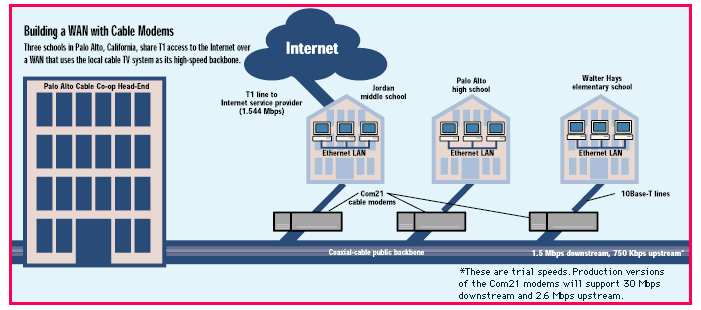 Extending a WAN with Cable Modems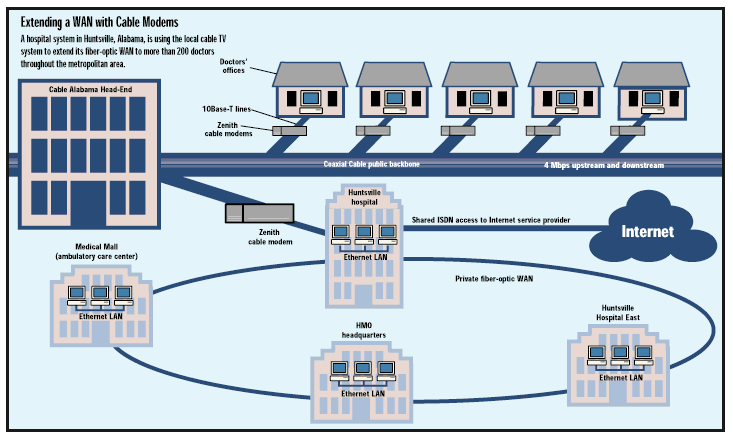 A hospital system in Huntsville, Alabama, is using the local cable TV system to extend its fiber-optic WAN to more than 200 doctors throughout the metropolitan area. Inside a Broadband Modem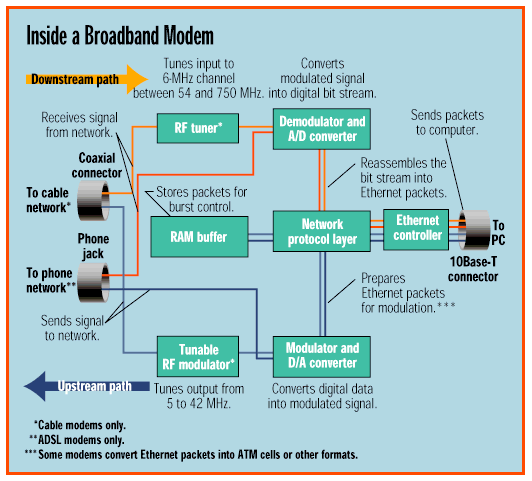 The Bandits of Bandwidth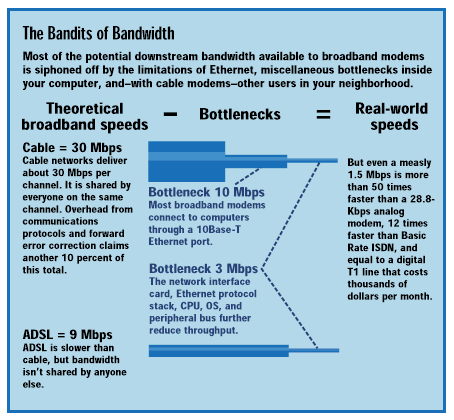 A Hybrid Fiber-Coaxial Network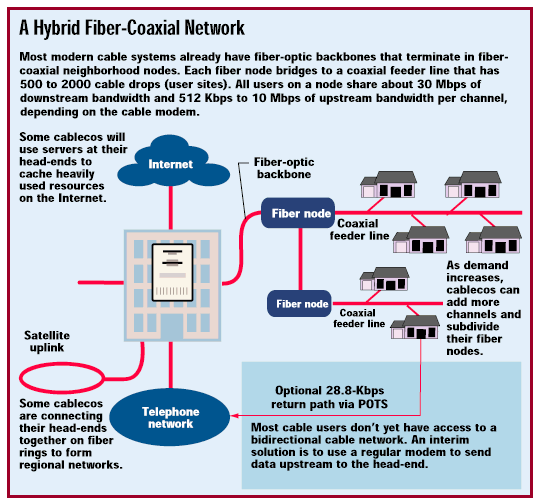 HFC Frequency Allocations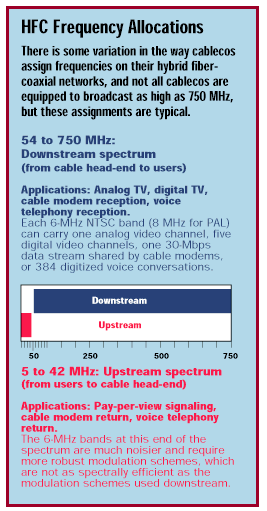 Broadband by the Numbers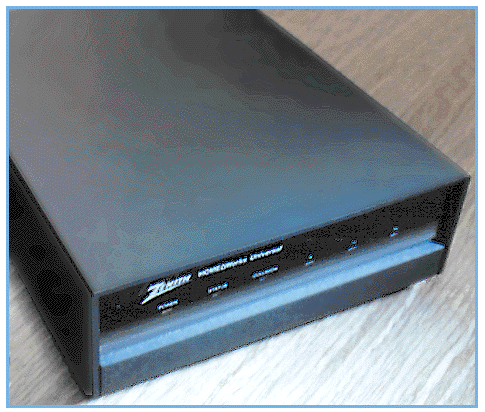 What you get: Unlimited Internet access and lease of a modem; 9-30 Mbps bandwidth potential; POTs line remains available for simultaneous phone calls; instant on-line connections: no delays for dial-up and protocol negotiation procedures. Tom R. Halfhill is a BYTE senior editor based in San Mateo, California. You can reach him on the Internet at thalfhill@bix.com. Inbox / December 1996Which Bottleneck?First I read Tom Halfhill's wide-ranging feature "Break the Bandwidth Barrier" (September cover story). Then I read Mark Schlack's editorial about the new fast networks at Boston College — clearly a major step forward. Then I had an uncomfortable thought: Many households will soon be able to connect to the Internet with 10-Mbps Ethernet-like links. Where are all those bits going to come from? When I request a multimedia offering from the Disney or the Silicon Graphics site, they will have to dedicate a 10-Mbps stream to me. If all the other people requesting the service start at different times, the bandwidth of the server will have to be massive! Perhaps your next feature could cover this end of the problem. Alan C. Pickwick Sale, Cheshire, U.K. 100316.3710@compuserve.com When you request data, the Web server receives your request and schedules it in priority to other such requests. It doesn't service your request to the exclusion of all others but shares its bandwidth — which is limited by its own connection to the Internet — among all users. If the aggregate bandwidth of all simultaneous requests for data exceeds the capacity of the server's own connection, then somebody is going to wait. This will get worse as the number of Internet users, and the amount of bandwidth they have, increases. That's why broadband modems are only part of the total solution; there will always be a bottleneck somewhere. Broadband modems, however, move that bottleneck off the desktop for the first time. — Tom Halfhill, senior editor. Copyright 1994-1998 BYTE |
